初高中衔接练习
- 格式:doc
- 大小:122.00 KB
- 文档页数:5
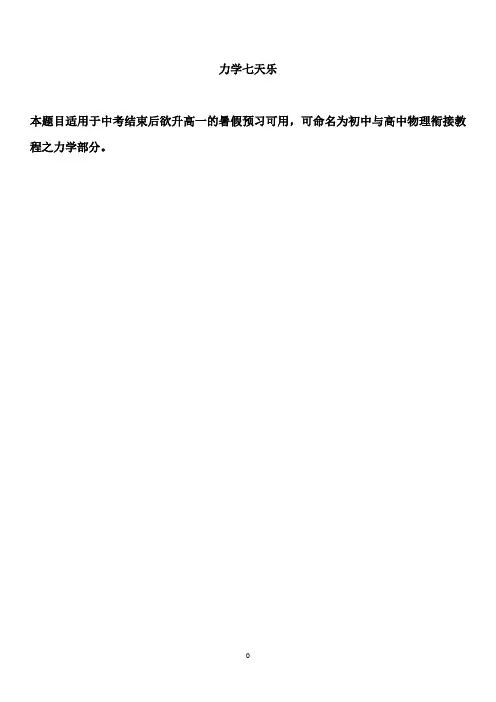
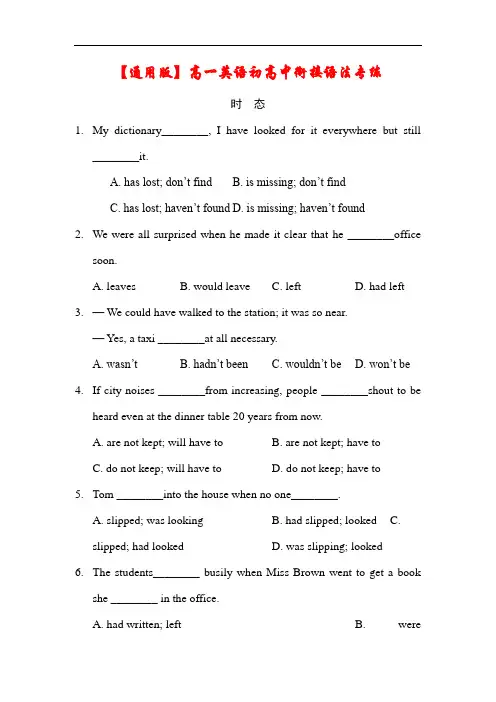
【通用版】高一英语初高中衔接语法专练时态1.My dictionary________, I have looked for it everywhere but still________it.A. has lost; don’t findB. is missing; don’t findC. has lost; haven’t foundD. is missing; haven’t found2.We were all surprised when he made it clear that he ________officesoon.A. leavesB. would leaveC. leftD. had left3.— We could have walked to the station; it was so near.— Yes, a taxi ________at all necessary.A. wasn’tB. hadn’t beenC. wouldn’t beD. won’t be4.If city noises ________from increasing, people ________shout to beheard even at the dinner table 20 years from now.A. are not kept; will have toB. are not kept; have toC. do not keep; will have toD. do not keep; have to5.Tom ________into the house when no one________.A. slipped; was lookingB. had slipped; lookedC.slipped; had looked D. was slipping; looked6.The students________ busily when Miss Brown went to get a bookshe ________ in the office.A. had written; leftB. werewriting; has leftC. had written; had leftD. werewriting; had left7.We are proud of the achievements we ________since liberation.A. madeB. have madeC. makeD. will make8.He says he ________ the book several times in the past few years.A. has readB. had readC. readD. reads9.The egg must be bad. It ________off a terrible smell.A. was givingB. gaveC. is givingD. is given10.The telephone ________for two minutes before it was answered.A. has rungB. has been ringingC. had been ringingD. rings11.I ________to Beijing only once before.A. wentB. have goneC. have beenD. was12.— When are you going to meet him?— As soon as I ________my dinner.A. will finishB. finishC. am going to finishD.finishes13.By the end of last week we ________the task ahead of time.A. completedB. have completedC. was completingD. hadcompleted14.This time tomorrow I ________to Shanghai.A. will flyB. would flyC. am going to flyD. will beflying15.I can’t go swimming because I ________my leg.A. brokeB. had brokenC. have brokenD. have beenbroken16.I’m sorry but I ________that you ________a diary.A. don’t notice; are writingB. don’t notice; have writingC. didn’t notice; wroteD. didn’tnotice; were writing17.I didn’t know you ________your raincoat here when you ________tosee me the other day.A. had left; had comeB. had left; cameC. left; cameD. left; were coming18.________ be careful when ________your homework.A. Do; doingB. Do; doC. To; doingD. To; do19.— Are you going to the meeting?— No, the meeting ________until next Monday.A. will be put offB. has been put offC. will put offD. has put off20.He insisted that he ________ in good health.A. wasB. beC. isD. was being21.If the doctor ________an hour earlier, the boy would have beensaved.A. cameB. could comeC. should comeD. had come22.— What do you think ________to her?— She must have lost the ticket.A. happenedB. had happenedC. will happenD. happens23.Don’t be angry, ________you?A. willB. won’tC. doD. don’t24.I don’t know where he is. I might know now where he ________ hadI arrived here a little earlier.A. wasB. isC. should beD. must be25.He wrote to me ________that he ________ to see me in July.A. said; would comeB. said; will comeC. saying;would come D. saying; will come26.I’ll write to you as soon as I ________.A. arriveB. will arriveC. am going to arriveD. amarriving27.No sooner ________down ________the doorbell rang.A. had I sat; whenB. did I sat; thanC. I had sat; beforeD. had Isat; than28.________this Street and you ________there.A. Followed; will getB. Following; getC. Follow;will get D. Follow; get29.If she doesn’t visit the doctor, ________.A. neither will heB. neither won’t heC. nor does heD. nordoesn’t he30.No one ________out the cause of the trouble in the machines untilyesterday.A. has foundB. was findingC. had foundD. would find31.I won’t bel ieve you until I ________you sing the song with my owneyes.A. heardB. will hearC. have heardD. had heard32.I ________ a cold for several days. can you help me get rid of it?A. haveB. have hadC. had hadD. am having33.He ________. The painting will be finished soon.A. has paintedB. paintedC. was paintingD. has beenpainting34.She said that he ________ to Chengdu.A. has never beenB. had never beenC. will goD. wouldsend35.Look! The boy you ________in the park the other day________towards us.A. met; is runningB. had workedC. meet; will runD. has met;runs36.You must be very tired; you ________for quite a long time.A. workedB. had workedC. has workedD. areworking37.— Have they started building a house for you?— Yes, it ________now.A. is buildingB. has buildC. has startedD. is beingbuilt38.May fifth is my birthday. I ________a small party.A. will planB. am to planC. plannedD. amplanning39.Tom ________that most of the guests________ when he arrived atthe party.A. disappointed; had leftB. had beendisappointed; leftC. was disappointed; had leftD. had disappointed; left40.He must have washed the shirt, ________he?A. didn’tB. haven’tC. mustn’tD. can41.I don’t know when he ________, but when he ________I shall let youknow.A. comes; will comeB. will come; comesC. comes;comes D. will come; came42.I ________to the seaside until I went to Hainan.A. would never goB. have never beenC. did never goD. had neverbeen43.You’d be sorry if you ________an accident on the journey.A. haveB. hadC. had hadD. wouldhave44.Can you see the sign over there, which ________: “Keep off thegrass”A. readsB. is readC. readingD. has read45.When I ________down the street the other day, I happened to notice aleather wallet lying on the ground.A. walkingB. was walkingC. walkedD. was towalk46.At this time tomorrow Grandpa________ at the table with us.A. sitB. sitsC. is sittingD. will besitting47.What happened when they ________TV?A. watchedB. will watchC. are watchingD. werewatching48.Look Out! ________the dog.A. Out rushesB. Out rushedC. Out is rushingD. Rushedout49.I want to try on the coat you bought yesterday, where ________?A. was itB. is itC. has it beenD. did youput50.He is now in America. It ________3 years since he ________Wuhan.A. is; leftB. is; has been away fromC. was; hadleft D. has been; has left51.________when it began to rain.A. Hardly did he arriveB. Hardly hehad arrivedC. Hardly he arrivedD. Hardlyhad he arrived52.________as if he had been ill for a long time.A. He seemedB. He lookedC. It lookedD. It seems53.He ________to go into hospital if his illness gets worse.A. hadB. must haveC. will haveD. has54.The teacher said the Yellow River ________the second longest riverin China.A. isB. wasC. will beD. has been55.Somebody ________my pen, for it ________on my desk.A. must take; isn’tB. must have taken; isn’tC. took; had beenD. might have taken; wasn’t56.Would you mind if I ________on the radio?A. turnB. turnedC. will turnD. shouldturn57.She is happy ________the watch she lost.A. to foundB. to findC. to have foundD. finding58.I don’t think he ________able to pick out my friends in such a bigcrowd.A. isB. can beC. will beD. should be59.I happened________ when Miss Li came for a visit.A. to readB. to have readC. to be readingD. that I was reading a book60.I’d rather you ________tomorrow.A. comeB. cameC. will comeD. wouldcome1—10. DBAAA DBACC 11—20.CBDDC DCABA 21—30. DAABC ADCAC 31—40. CBDBA CDDCA 41—50. BDBAB DDABA 51—60. DBCAB ACCCB。
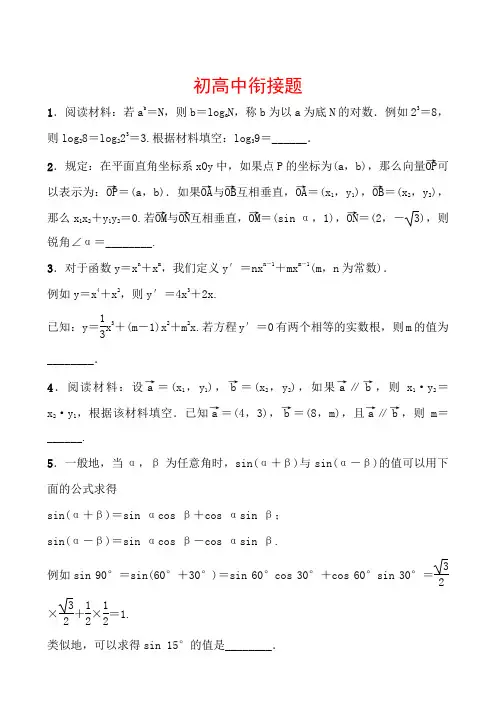
初高中衔接题1.阅读材料:若a b =N ,则b =log a N ,称b 为以a 为底N 的对数.例如23=8,则log 28=log 223=3.根据材料填空:log 39=______.2.规定:在平面直角坐标系xOy 中,如果点P 的坐标为(a ,b),那么向量OP →可以表示为:OP →=(a ,b).如果OA →与OB →互相垂直,OA →=(x 1,y 1),OB →=(x 2,y 2),那么x 1x 2+y 1y 2=0.若OM →与ON →互相垂直,OM →=(sin α,1),ON →=(2,-3),则锐角∠α=________.3.对于函数y =x n +x m ,我们定义y′=nx n -1+mx m -1(m ,n 为常数). 例如y =x 4+x 2,则y′=4x 3+2x.已知:y =13x 3+(m -1)x 2+m 2x.若方程y′=0有两个相等的实数根,则m 的值为________.4.阅读材料:设a →=(x 1,y 1),b →=(x 2,y 2),如果a →∥b →,则x 1·y 2=x 2·y 1,根据该材料填空.已知a →=(4,3),b →=(8,m),且a →∥b →,则m =______.5.一般地,当α,β为任意角时,sin(α+β)与sin(α-β)的值可以用下面的公式求得sin(α+β)=sin αcos β+cos αsin β; sin(α-β)=sin αcos β-cos αsin β.例如sin 90°=sin(60°+30°)=sin 60°cos 30°+cos 60°sin 30°=32×32+12×12=1. 类似地,可以求得sin 15°的值是________.6.将四个数a ,b ,c ,d 排成两行、两列,两边各加上一条竖线段,记成⎪⎪⎪⎪⎪⎪⎪⎪a b c d ,定义:⎪⎪⎪⎪⎪⎪⎪⎪a b c d =ad -bc ,上述记号就叫做二阶行列式,若⎪⎪⎪⎪⎪⎪⎪⎪22x13-x 1x -3=10,则x =________. 7.阅读材料:定义:如果一个数的平方等于-1,记为i 2=-1,这个数i 叫做虚数单位,把形如a +bi(a ,b 为实数)的数叫做复数,其中a 叫这个复数的实部,b 叫这个复数的虚部.它的加、减、乘法运算与整式的加、减、乘法运算类似.例如计算:(4+i)+(6-2i)=(4+6)+(1-2)i =10-i ; (2-i)(3+i)=6-3i +2i -i 2=6-i -(-1)=7-i ; (4+i)(4-i)=16-i 2=16-(-1)=17; (2+i)2=4+4i +i 2=4+4i -1=3+4i. 根据以上信息,完成下面计算: (1+2i)(2-i)+(2-i)2=________.8.已知:对于任意实数a ,b ,总有a 2+b 2≥2ab,且当a =b 时,代数式a 2+b 2取得最小值为2ab.若一个矩形的面积固定为n ,它的周长是否会有最值?若有,求出周长的最值及此时矩形的长和宽;若没有,请说明理由.9.现场学习:观察一列数:1,2,4,8,16,…,这一列数按规律排列,我们把它叫做一个数列,其中的每个数,叫做这个数列中的项,从第二项起,每一项与它的前一项的比都等于2,我们把这个数列叫做等比数列,这个常数2叫做这个等比数列的公比.一般地,如果一列数从第二项起,每一项与它的前一项的比都等于同一个常数,这一列数就叫做等比数列,这个常数就叫做等比数列的公比. 解决问题:(1)已知等比数列5,-15,45,…,那么它的第六项是________;(2)已知一个等比数列的各项都是正数,且第2项是10,第4项是40,则它的公比为________;(3)如果等比数列a 1,a 2,a 3,a 4,…,公比为q ,那么有a 2=a 1q ,a 3=a 29=(a 1q)q =a 1q 2,…,a n =________.(用a 1与q 的式子表示,其中n 为大于1的自然数)10.阅读下面材料:我们知道一次函数y =kx +b(k≠0,k ,b 是常数)的图象是一条直线,到高中学习时,直线通常写成Ax +By +C =0(A≠0,A ,B ,C 是常数)的形式,点P(x 0,y 0)到直线Ax +By +C =0的距离可用公式d =|Ax 0+By 0+C|A 2+B 2计算.例如:求点P(3,4)到直线y =-2x +5的距离.解:∵y=-2x +5,∴2x+y -5=0,其中A =2,B =1,C =-5, ∴点P(3,4)到直线y =-2x +5的距离 d =|Ax 0+By 0+C|A 2+B 2=|2×3+1×4-5|22+12=55= 5. 根据以上材料解答下列问题:(1)求点Q(-2,2)到直线3x -y +7=0的距离;(2)如图,直线y =-x 沿y 轴向上平移2个单位得到另一条直线,求这两条平行直线之间的距离.11.如果函数y =f(x)满足:对于自变量x 的取值范围内的任意x 1,x 2. ①若x 1<x 2,都有f(x 1)<f(x 2),则称f(x)是增函数; ②若x 1<x 2,都有f(x 1)>f(x 2),则称f(x)是减函数. 例题:证明函数f(x)=6x (x>0)是减函数.证明:设0<x 1<x 2,f(x 1)-f(x 2)=6x 1-6x 2=6x 2-6x 1x 1x 2=6(x 2-x 1)x 1x 2.∵0<x 1<x 2, ∴x 2-x 1>0,x 1x 2>0,∴6(x 2-x 1)x 1x 2>0,即f(x 1)-f(x 2)>0.∴f(x 1)>f(x 2).∴函数f(x)=6x (x>0)是减函数.根据以上材料,解答下面的问题: 已知函数f(x)=1x2+x(x<0),f(-1)=1(-1)2+(-1)=0,f(-2)=1(-2)2+(-2)=-74.(1)计算:f(-3)=______,f(-4)=______;(2)猜想:函数f(x)=1x 2+x(x<0)是________函数(填“增”或“减”);(3)请仿照例题证明你的猜想.参考答案1.2 2.60° 3.12 4.6 5.6-24 6.4 7.7-i8.解:设矩形的长为a ,宽为b(a≥b>0).周长C =2(a +b)≥4ab =4n ,且当a =b 时,代数式2(a +b)取得最小值为4n ,此时a =b =n.故若一个矩形的面积固定为n ,它的周长有最小值,周长的最小值为4n ,此时矩形的长和宽均为n. 9.解:(1)-1 215提示:5×(-3)6-1=-1 215. (2)2 (3)a n =a 1q n -110.解:(1)∵3x-y +7=0, ∴A=3,B =-1,C =7. ∵点Q(-2,2),∴d=|-2×3-1×2+7|32+(-1)2=110=1010, ∴点Q(-2,2)到直线3x -y +7=0的距离为1010.(2)直线y =-x 沿y 轴向上平移2个单位得到另一条直线为y =-x +2. 在直线y =-x 上任意取一点P , 当x =0时,y =0, ∴P(0,0). ∵直线y =-x +2, ∴A=1,B =1,C =-2, ∴d=|0+0-2|12+12=2, ∴两平行线之间的距离为 2. 11.解:(1)-269 -6316(2)增(3)设x1<x2<0,f(x1)-f(x2)=1x12+x1-1x22-x2=(x1-x2)(1-x1+x2x12x22).∵x1<x2<0,∴x1-x2<0,x1+x2<0,∴f(x1)-f(x2)<0,∴f(x1)<f(x2),∴函数f(x)=1x2+x(x<0)是增函数.。
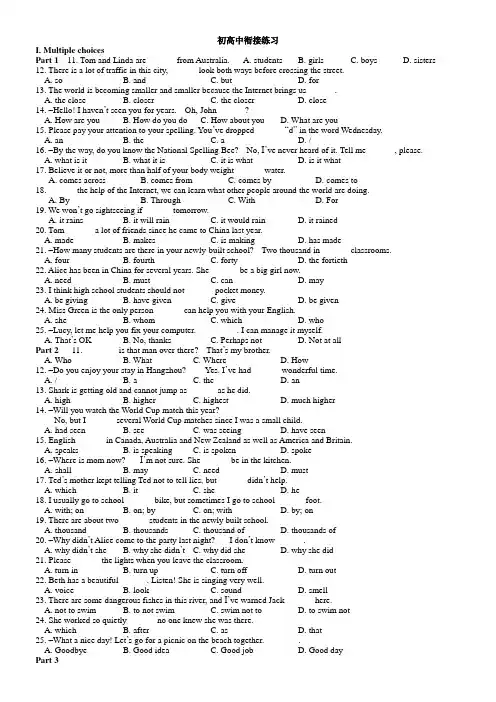
初高中衔接练习I. Multiple choicesPart 1 11. Tom and Linda are ______ from Australia. A. students B. girls C. boys D. sisters12. There is a lot of traffic in this city, ______ look both ways before crossing the street.A. soB. andC. butD. for13. The world is becoming smaller and smaller because the Internet brings us ______.A. the closeB. closerC. the closerD. close14. –Hello! I haven’t seen you for years. --Oh, John ______?A. How are youB. How do you doC. How about youD. What are you15. Please pay your attention to your spelling. You’ve dropped ______ “d” in the word Wednesday.A. anB. theC. aD. /16. –By the way, do you know the National Spelling Bee? --No, I’ve never heard of it. Tell me ______, please.A. what is itB. what it isC. it is whatD. is it what17. Believe it or not, more than half of your body weight ______ water.A. comes acrossB. comes fromC. comes byD. comes to18. ______ the help of the Internet, we can learn what other people around the world are doing.A. ByB. ThroughC. WithD. For19. We won’t go sightseeing if ______ tomorrow.A. it rainsB. it will rainC. it would rainD. it rained20. Tom ______ a lot of friends since he came to China last year.A. madeB. makesC. is makingD. has made21. –How many students are there in your newly-built school? --Two thousand in ______ classrooms.A. fourB. fourthC. fortyD. the fortieth22. Alice has been in China for several years. She ______ be a big girl now.A. needB. mustC. canD. may23. I think high school students should not ______ pocket money.A. be givingB. have givenC. giveD. be given24. Miss Green is the only person ______ can help you with your English.A. sheB. whomC. whichD. who25. –Lucy, let me help you fix your computer. --______. I can manage it myself.A. That’s OKB. No, thanksC. Perhaps notD. Not at allPart 2 11. --______ is that man over there? --That’s my brother.A. WhoB. WhatC. WhereD. How12. –Do you enjoy your stay in Hangzhou? --Yes. I’ve had ______ wonderful time.A. /B. aC. theD. an13. Shark is getting old and cannot jump as ______ as he did.A. highB. higherC. highestD. much higher14. –Will you watch the World Cup match this year?--No, but I ______ several World Cup matches since I was a small child.A. had seenB. seeC. was seeingD. have seen15. English ______ in Canada, Australia and New Zealand as well as America and Britain.A. speaksB. is speakingC. is spokenD. spoke16. –Where is mom now? --I’m not sure. She ______ be in the kitchen.A. shallB. mayC. needD. must17. Ted’s mother kept telling Ted not to tell lies, but ______ didn’t help.A. whichB. itC. sheD. he18. I usually go to school ______ bike, but sometimes I go to school ______ foot.A. with; onB. on; byC. on; withD. by; on19. There are about two ______ students in the newly built school.A. thousandB. thousandsC. thousand ofD. thousands of20. –Why didn’t Alice come to the party last night? --I don’t know ______.A. why didn’t sheB. why she didn’tC. why did sheD. why she did21. Please ______ the lights when you leave the classroom.A. turn inB. turn upC. turn offD. turn out22. Beth has a beautiful ______. Listen! She is singing very well.A. voiceB. lookC. soundD. smell23. There are some dangerous fishes in this river, and I’ve warned Jack ______ here.A. not to swimB. to not swimC. swim not toD. to swim not24. She worked so quietly ______ no one knew she was there.A. whichB. afterC. asD. that25. –What a nice day! Let’s go for a picnic on the beach together. --______.A. GoodbyeB. Good ideaC. Good jobD. Good dayPart 31.All pilots must ____ the passengers safety.A. be responsible forB. be responsible toC. respond forD. respond to2.“ Is there ____ here?” Mary entered the room and shouted.A. anybodyB. somebodyC. somethingD. anything3.______ Chinese, we study English , maths, physics in school.A. ExceptB. BesidesC. BesideD. Without4.If it is true, it _____ interesting questions.A. raisedB. roseC. raisesD. rises5.The two _____ found their luggage in the end.A. GermanB. GermenC. GermansD. Germany6.Is a human brain a more powerful ____ than a computer?A. calculateB. calculationC. calculatingD. calculator7.His father as well as us _____ his work.A. are pleased withB. is pleased withC. are pleased ofD. is pleased for8.– Which of the two English dictionaries will you buy?– I will buy _____ of them , so I can give one to my friend, Helen.A. eitherB. neitherC. bothD. all9.The students of Class Three have already finished the ____ lessons.A. twenty –fifthB. twenty-ninethC. 23thD. twentieth-six10.Everybody in Troy went to sleep _____ the guards.A. includeB. includesC. includingD. included11.Because of his poor health, his dream of becoming a basketball player could not be realized.A. come trueB. be recognizedC. be rememberedD. be recalled12.The boy ______ the spelling mistake.A. aware ofB. was unaware ofC. is unawareD. unaware of13.Everybody should _____ the environment ____ pollution.A. prevent…fromB. protect…fromC. stop…fromD. keep…from14.The kind old lady ____ the poor dog as I he were her son.A. looked afterB. looked forward toC. looked forD. looked through15.Chris is a _____. The police think he killed the old man and are trying to catch him.A. suspectB. criminalC. detectiveD. guilty16.The famous detective told me about a(n) _____he dealt with last moth.A. storyB. actionC. adventureD. case17. The antique shop sometimes sells fakes. They ______ customers from time to times.A. sellB. cheatC. attackD. purchase18.If you _____ a crime, you must expect to be punished by law.A. watchB. commitC. makeD. find19.A young man in black ____ Mrs White’s bracelet last week.A. robbed ofB. robbedC. stoleD. stole of20.Doris _____ for six years.A. was in prisonB. put into jailC. was sent into prisonD. went into jailII. 完形填空When I was three years old just before my sister was born, my mom asked me what we should name the new baby. I said, “Let’s call 26 Gravy(肉汁)!”You know, we pour gravy over meat and it tastes good! My parents found my 27 interesting, but named the new baby Caroline, instead.Having a sister 28 my life. When my sister and I played together, we 29 got into fights and got angry with each other if we did 30 wrong. It sometimes drove our parents crazy. 31 at the same time, we learned to share our things and to forgive(原谅) each other when we got 32 .In North America, there are many kinds of families, but 33 families have a boy and a girl. Of course, some have three or more. In China, most children 34 have brothers or sisters, and they have to learn those things in other ways, which is more 35 .When I 36 away to university, my sister 37 me she wished I still lived at 38 . She wasn’t used to getting all the attention from my parents. But Chinese children get all the attention for all their life!Some middle school 39 in China wish they had a brother or sister. If you are one of them, I 40 a good idea for you. Treat your friends and classmates as your brothers and sisters!26. A. her B. him C. me D. them27. A. news B. idea C. lesson D. story28. A. began B. saw C. changed D. enjoyed29. A. never B. again C. seldom D. often30. A. something B. everything C. anything D. nothing31. A. But B. So C. Or D. Through32. A. angry B. excited C. hungry D. worried33. A. few B. several C. all D. most34. A. shouldn’t B. don’t C. needn’t D. wouldn’t35. A. beautiful B. difficult C. careful D. friendly36. A. took B. put C. moved D. came37. A. asked B. answered C. told D. warned38. A. home B. work C. school D. family39. A. students B. teachers C. workers D. lovers40. A. give B. have f C. learn D. makeIII. 阅读理解A) I have never taken cooking classes. I learned cooking from my mother because she was really interested in teaching me how to cook. The main reason for this was because when my mother got married, she didn’t know how to cook anything, not even an egg. My grandmother never allowed her to stay in the kitchen when she was cooking.My mother did not start to cook until she was 25 years old. In the beginning, it was very hard for her. Therefore, she had to take cooking classes to prepare our meals. After having that experience, she decided to teach me how to cook because she didn’t want me to have the same experience.I remember when I was seven years old, and my other was cooking, I was with her in the kitchen enjoying cooking.I always helped her. Sometimes we prepared meals that my mother already knew how to make, and sometimes we prepared them from recipes. Nowadays, I am really thankful for that experience because I don’t need help to cook a meal.I can cook for me alone or for a group of people; it doesn’t matter.I will do the same with my children because I don’t want them to have the same experience as my mother. If one day I am not with them, I want to be sure that they can carry on their lives without me.41. The writer’s mother learned cooking ______.A. from the writer’s grandmotherB. all by herselfC. by taking cooking classD. from cooking books42. The writer’s mother taught the writer how to cook because ______.A. she wanted the writer to be more independent(独立)B. the writer was interested in cookingC. she thought it a must for a woman to learnD. she needed more help when she was cooking43. The underlined work “recipes” in this passage most probably means ______.A. instructions on how to prepare foodB. experiences of cooking foodC. some well-known cooksD. tools for cooking and heating food44. We can learn from the passage that the writer’s children will ______.A. hate cookingB. learn cookingC. teach cookingD. forget cooking45. The writer must think cooking is ______ to learn in life.A. interestingB. difficultC. enjoyableD. importantB) Banbury House Tel: 564839Enjoying mixing with other students in pleasant accommodation (住宿) 30 minutes from the station and close to all main bus routes. Single and double rooms. Students provide own food but all cleaning services offered. Please bring your own bed things.Three Seasons Tel: 445987We can provide all types of accommodation for all types of single student. Rooms are fully prepared with bed things and have reasonable prices. Full board possible. 35—40 minutes from main universities and the city.Sturtin Hostel Tel: 876333We offer beautiful views. It lies in pleasant countryside. Relax after a long day by swimming in the pool or using the exercise gym. Separate study rooms available. No children. Bar & restaurant.First Shop Tel: 223300Ideal for new students, we provide double rooms. If you wish, we can offer help in finding a suitable person to share a room with. All washing and cleaning services offered at extra charge. Large canteen and three bathrooms on each floor.46. Which number would you ring if you are interested in sports?A. 564829B. 445987C. 876333D. 22330047. ______ offers help in finding a room-mate.A. Banbury HouseB. Three SeasonsC. Sturtin HostelD. First Shop48. If you live in Banbury House, you have to ______.A. do cooking by yourselfB. do cleaning by yourselfC. travel by trainD. take a school bus49. The articles above are mainly for ______.A. family accommodationB. student accommodationC. travel accommodationD. cheap accommodation50. The four texts above are most probably ______.A. lettersB. noticesC. invitationsD. advertisementsC) Many years ago when people had no thermometers(温度计), they usually touched a thing to see how hot or cold it was. The following experiment shows easy it was to make a mistake.Take three glasses: the first one with very hot water, the second one with very cold water, and the third one with water at room temperature. Then you put a finger of one hand in the hot water, and a finger of the other hand in the cold water. You hold your fingers in the two glasses for a That is minute. Then you use each finger, one after another, one after another, to see how hot or cold the water in the third glass is. You will find that the water is warm to the finger that was in the cold water before, but the finger which was in the hot water will feel cold in the same glass of water.That is why you must always find the temperature in a scientific way. You must not try to tell the temperature as it seems to you.You will often make a mistake if you take something that seems to you for a real fact. For example, when you are going to an Amusement park by bus and you want to get there very quickly, it seems to you that your bus is going very slowly, slower than the other buses. But if it is Sunday and you have much free time, it seems to you all the buses and cars are going very fast.51. The experiment tells us that sometimes it is ______ to make a mistake.A. interestingB. difficultC. easyD. helpful52. The water in the third glass is ______.A. colder than the water in the first glassB. hotter than the water in the first glassC. colder than the water in the second glassD. as cold as the water in the second glass53. What will you find if you put the finger which was in the first glass into the second glass according to theexperiment?A. The water is hotter than it is in the first glass.B. The water is as hot as it is in the first glass.C. The water is at room temperature.D. The water is colder than it is in the first glass.54. How should we find the temperature according to the passage?A. Try to tell as it seems to us.B. Try to use our fingers.C. Try to tell in a scientific way.D. Try to touch something to see how hot it is.55. We can learn something about ______ from the passage.A. physicsB. chemistryC. psychology(心理学)D. biology(生物学)IV56a meal. Today, fast food is 57 cheap, which makes it even more attractive. And it is everywhere—not only in the United States 58 around the world. Now, 59 , there is a group of people who would like to see us stop 60 so much fast food. These people belong to the Slow Food Movement.The Slow Food Movement started in Italy in 1986. It was 61 by Carlo Petrini, a food critic who 62 owned a restaurant. He and his friends wanted to encourage more people to slow 63 and learn to prepare and enjoy good food again. 64 began by meeting in small 65 to organize dinners and wine tastings. They also began to encourage 66 local farmers to go back to the old ways of growing food and caring for farm animals. They felt that food that was raised carefully tasted 67 .This small Italian group grew, 68 in 1989 the International Slow Food Movement was born in Paris. Today there 69 78,000 members in 100 countries. There is also a 70 magazine, printed in six languages, including Japanese.V. 短文改错Cell phones can be see almost everywhere in 71. ________school now. Many teacher say that we students 72. ________should not use cell phones at school. But I think 73. ________it should be allowed to use at school because 74. ________we want to get touch with our parents. Cell 75. ________phones can be used almost anywhere or at any 76. ________time. What more, cell phones can be great fun, 77. ________too. Besides make phone calls, we can also play 78. ________games and sent text messages to our friends by 79. ________cell phone. Don’t you think of they are necessary? 80. ________VI. 书面表达假如你刚去澳大利亚的一所高中读书,在上第一节课时,你填(打勾)了一张表格(见听力测试第二大题)。
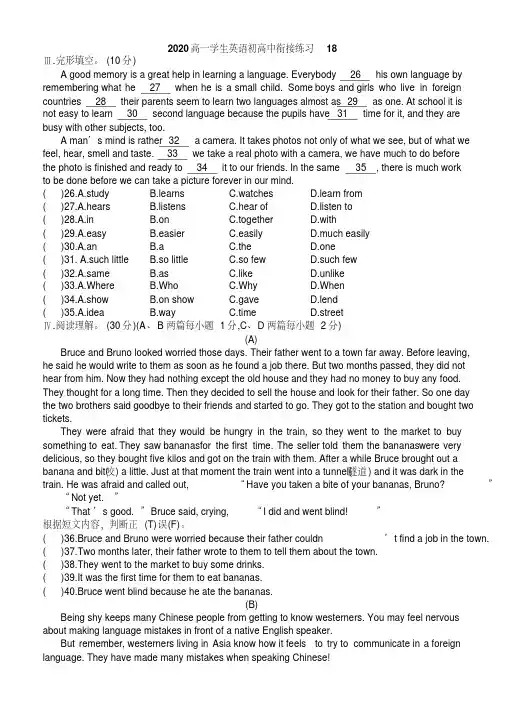
2020高一学生英语初高中衔接练习18Ⅲ.完形填空。
(10分)A good memory is a great help in learning a language. Everybody 26 his own language by remembering what he 27 when he is a small child. Some boys and girls who live in foreign countries 28 their parents seem to learn two languages almost as 29 as one. At school it isnot easy to learn 30 second language because the pupils have 31 time for it, and they arebusy with other subjects, too.A man’s mind is rather 32 a camera. It takes photos not only of what we see, but of what we feel, hear, smell and taste. 33 we take a real photo with a camera, we have much to do beforethe photo is finished and ready to 34 it to our friends. In the same 35 , there is much workto be done before we can take a picture forever in our mind.( )26.A.study B.learns C.watches D.learn from( )27.A.hears B.listens C.hear of D.listen to( )28.A.in B.on C.together D.with( )29.A.easy B.easier C.easily D.much easily( )30.A.an B.a C.the D.one( )31. A.such little B.so little C.so few D.such few( )32.A.same B.as C.like D.unlike( )33.A.Where B.Who C.Why D.When( )34.A.show B.on show C.gave D.lend( )35.A.idea B.way C.time D.streetⅣ.阅读理解。
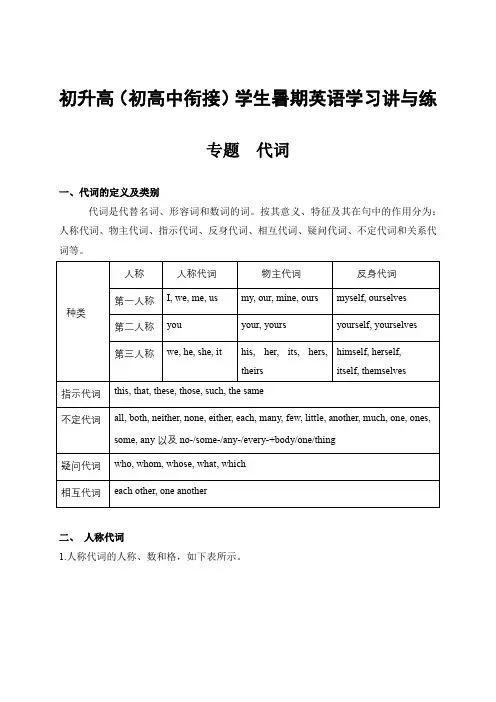
初升高(初高中衔接)学生暑期英语学习讲与练专题代词一、代词的定义及类别代词是代替名词、形容词和数词的词。
按其意义、特征及其在句中的作用分为:人称代词、物主代词、指示代词、反身代词、相互代词、疑问代词、不定代词和关系代词等。
二、人称代词1.人称代词的人称、数和格,如下表所示。
2.人称代词有主格和宾格之分。
通常主格作主语,宾格作宾语。
如:I like table tennis. (作主语)Do you know him?(作宾语)3.人称代词还可作表语。
作表语时用宾格。
如:---Whos is knocking at the door?---It’s me.4.人称代词在than之后与其他人或事物进行比较时,用主格和宾格都可以。
如:He is older than me.He is older than I am.三、物主代词1.表示所有关系的代词叫物主代词。
物主代词分形容词性物主代词和名词性物主代词,如下表所示。
2. 形容词性物主代词的作用相当于形容词,可在句中作定语。
例如:Our teacher is coming to see us.This is her pencil-box.3. 名词性物主代词的作用相当于名词,在句中可用作主语、宾语和表语。
Our school is here, and theirs is there.(作主语)--- Is this English-book yours? (作表语)--- No. Mine is in my bag.I've already finished my homework. Have you finished yours? (作宾语)四、指示代词指示代词包括:this,that,these,those。
1. this和these一般用来指在时间或空间上较近的事物或人,that和those则指时间和空间上较远的事物或人,例如:This is a pen and that is a pencil.We are busy these days.In those days the workers had a hard time.2. 有时that和those指前面讲到过的事物,this 和these则是指下面将要讲到的事物,例如:I had a cold. That's why I didn't come.What I want to say is this ; pronunciat ion is very important in learning English.3. 有时为了避免重复提到的名词,常可用that或those代替,例如:Television sets made in Beijing are just as good as those made in Shanghai.4. this 在电话用语中代表自己,that 则代表对方。
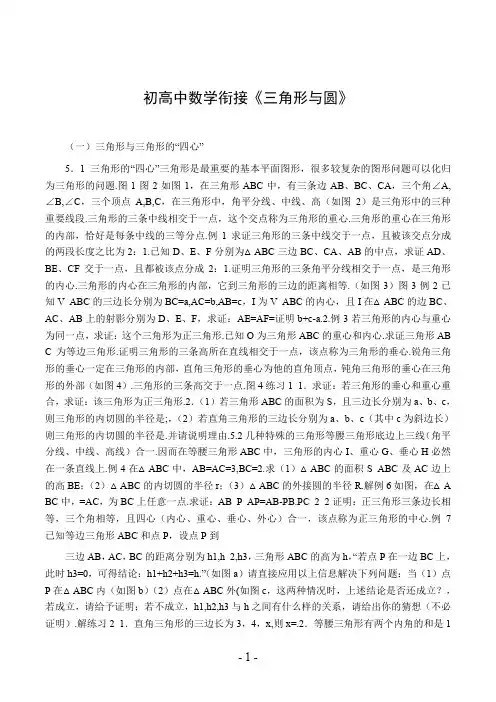
初高中数学衔接《三角形与圆》(一)三角形与三角形的“四心”5.1三角形的“四心”三角形是最重要的基本平面图形,很多较复杂的图形问题可以化归为三角形的问题.图1图2如图1,在三角形ABC中,有三条边AB、BC、CA,三个角∠A,∠B,∠C,三个顶点A,B,C,在三角形中,角平分线、中线、高(如图2)是三角形中的三种重要线段.三角形的三条中线相交于一点,这个交点称为三角形的重心.三角形的重心在三角形的内部,恰好是每条中线的三等分点.例1求证三角形的三条中线交于一点,且被该交点分成的两段长度之比为2:1.已知D、E、F分别为△ABC三边BC、CA、AB的中点,求证AD、BE、CF交于一点,且都被该点分成2:1.证明三角形的三条角平分线相交于一点,是三角形的内心.三角形的内心在三角形的内部,它到三角形的三边的距离相等.(如图3)图3例2已知V ABC的三边长分别为BC=a,AC=b,AB=c,I为V ABC的内心,且I在△ABC的边BC、AC、AB上的射影分别为D、E、F,求证:AE=AF=证明b+c-a.2.例3若三角形的内心与重心为同一点,求证:这个三角形为正三角形.已知O为三角形ABC的重心和内心.求证三角形AB C为等边三角形.证明三角形的三条高所在直线相交于一点,该点称为三角形的垂心.锐角三角形的垂心一定在三角形的内部,直角三角形的垂心为他的直角顶点,钝角三角形的垂心在三角形的外部(如图4).三角形的三条高交于一点.图4练习1 1.求证:若三角形的垂心和重心重合,求证:该三角形为正三角形.2.(1)若三角形ABC的面积为S,且三边长分别为a、b、c,则三角形的内切圆的半径是;,(2)若直角三角形的三边长分别为a、b、c(其中c为斜边长)则三角形的内切圆的半径是.并请说明理由.5.2几种特殊的三角形等腰三角形底边上三线(角平分线、中线、高线)合一.因而在等腰三角形ABC中,三角形的内心I、重心G、垂心H必然在一条直线上.例4在△ABC中,AB=AC=3,BC=2.求(1)△ABC的面积S ABC及AC边上的高BE;(2)△ABC的内切圆的半径r;(3)△ABC的外接圆的半径R.解例6如图,在△A BC中,=AC,为BC上任意一点.求证:AB P AP=AB-PB.PC 2 2证明:正三角形三条边长相等,三个角相等,且四心(内心、重心、垂心、外心)合一,该点称为正三角形的中心.例7已知等边三角形ABC和点P,设点P到三边AB,AC,BC的距离分别为h1,h 2,h3,三角形ABC的高为h,“若点P在一边BC上,此时h3=0,可得结论:h1+h2+h3=h.”(如图a)请直接应用以上信息解决下列问题:当(1)点P在△ABC内(如图b)(2)点在△ABC外(如图c,这两种情况时,上述结论是否还成立?,若成立,请给予证明;若不成立,h1,h2,h3与h之间有什么样的关系,请给出你的猜想(不必证明).解练习2 1.直角三角形的三边长为3,4,x,则x=.2.等腰三角形有两个内角的和是100°,则它的顶角的大小是.3.满足下列条件的△ABC,不是直角三角形的是()A.b=a-c 2 2 2 B.∠C=∠A+∠B C.∠A:∠B:∠C=3:4:5 D.a:b:c=12:13:5 4.已知直角三角形的周长为3+3,斜边上的中线的长为1,求这个三角形的面积.5.证明:等腰三角形底边上任意一点到两腰的距离之和为一个常量.习题A组1.已知:在ABC中,AB=AC,∠BAC=120o,AD为BC 边上的高,则下列结论中,正确的是()A.AD=3 AB 2 B.AD=1 AB 2 C.AD=BD D.A D=2 BD 2 2.三角形三边长分别是6、8、10,那么它最短边上的高为()A.6 B.4.5 C.2.4 D.8 3.如果等腰三角形底边上的高等于腰长的一半,那么这个等腰三角形的顶角等于.4.已知:a,b,c是△ABC的三条边,a=7,b=10,那么c的取值范围是。
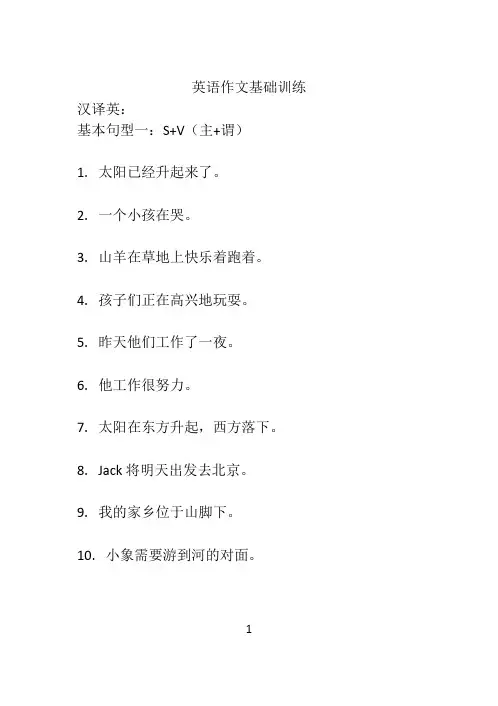
英语作文基础训练汉译英:基本句型一:S+V(主+谓)1.太阳已经升起来了。
2.一个小孩在哭。
3.山羊在草地上快乐着跑着。
4.孩子们正在高兴地玩耍。
5.昨天他们工作了一夜。
6.他工作很努力。
7.太阳在东方升起,西方落下。
8.Jack将明天出发去北京。
9.我的家乡位于山脚下。
10.小象需要游到河的对面。
111.游客们在大厅等着。
12.到目前为止,游客们在大厅已经等了3个小时了。
13.河北省位于河南省的北部。
14.这个婴儿朝我笑了。
15.昨天晚上上海大学发生了一场大火。
16.这场可怕的大火很快地蔓延了整个学生宿舍。
17.2019年11月一场致命的疾病发生在中国湖北省的武汉。
18.很多的市民因为这场疾病而去世了。
19.我们要勇敢地和疾病作斗争。
20.因为共产党的英明领导,医护人员的无私奉献和全国人民的团结一心,我们最终在与疾病的斗争中赢得胜利。
2答案1.The sun has risen.2.A child is crying.3.The goats are running happily on the grass.4.The children are playing happily.5.They worked all night yesterday.6.He works very hard.7.The sun rises in the east and sets in the west.8.Jack will leave for Beijing tomorrow.9.My hometown lies at the foot of the mountain.10. The baby elephant need swim across the river.11.The tourists are waiting in the hall.12.The tourists have been waiting in the hall for three hours so far.13.Hebei province lies in the north of Henan Province.14.The baby smiled at me.15.A big fire broke out in Shanghai University last night.16.The terrible fire quickly spread throughout the student dormitory.17. A deadly disease broke out /occurred in Wuhan, Hubei Province, China, in November 2019.18.Many citizens died of the disease.19.We must fight bravely against disease.320.Thanks to the wise leadership of the Communist Party, the selfless devotion/dedication of the medical workers and the unity of the whole nation, we finally won in the battle against the disease.4。
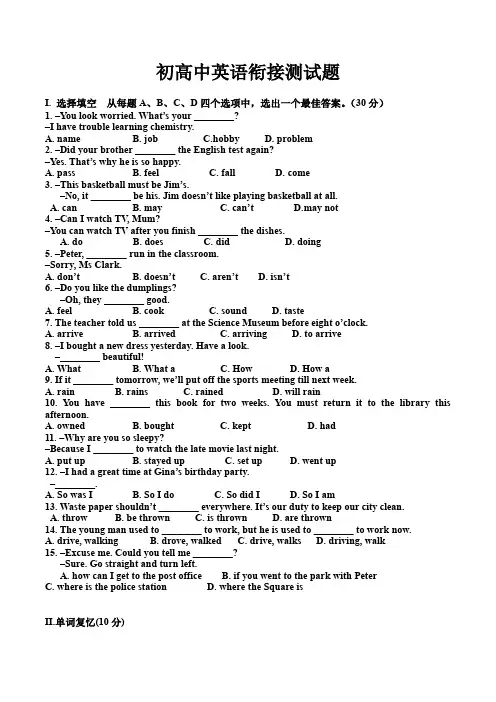
初高中英语衔接测试题I. 选择填空从每题A、B、C、D四个选项中,选出一个最佳答案。
(30分)1. –You look worried. What’s your ________?–I have trouble learning chemistry.A. nameB. jobC.hobbyD. problem2. –Did your brother ________ the English test again?–Yes. That’s why he is so happy.A. passB. feelC. fallD. come3. –This basketball must be Jim’s.–No, it ________ be his. Jim doesn’t like playing basketball at all.A. canB. mayC. can’tD.may not4. –Can I watch TV, Mum?–You can watch TV after you finish ________ the dishes.A. doB. doesC. didD. doing5. –Peter, ________ run in the classroom.–Sorry, Ms Clark.A. don’tB. doesn’tC. aren’tD. isn’t6. –Do you like the dumplings?–Oh, they ________ good.A. feelB. cookC. soundD. taste7. The teacher told us ________ at the Science Museum before eight o’clock.A. arriveB. arrivedC. arrivingD. to arrive8. –I bought a new dress yesterday. Have a look.–________ beautiful!A. WhatB. What aC. HowD. How a9. If it ________ tomorrow, we’ll put off the sports meeting till next week.A. rainB. rainsC. rainedD. will rain10. You have ________ this book for two weeks. You must return it to the library this afternoon.A. ownedB. boughtC. keptD. had11. –Why are you so sleepy?–Because I ________ to watch the late movie last night.A. put upB. stayed upC. set upD. went up12. –I had a great time at Gina’s birthday party.–________.A. So was IB. So I doC. So did ID. So I am13. Waste paper shouldn’t ________ everywhere. It’s our duty to keep our city clean.A. throwB. be thrownC. is thrownD. are thrown14. The young man used to ________ to work, but he is used to ________ to work now.A. drive, walkingB. drove, walkedC. drive, walksD. driving, walk15. –Excuse me. Could you tell me ________?–Sure. Go straight and turn left.A. how can I get to the post officeB. if you went to the park with PeterC. where is the police stationD. where the Square isII.单词复忆(10分)1.日记________2.建筑物________3.细心的________4.座位________5.演员________6.教育________7.meaningless________ 8.engineer________9.try one's best to do sth.________ 10.find out________III.指出下列句子的成分(可用汉语写)20分1.They are listening.2.My mother is fifty now.3.I have bought three books.4.My friend gave me a birthday present.5.I painted the wall white.6.The boss often makes the workers work twelve hours a day.7.They arrived at six o’clock.8.The map is on the wall.9.Children often sing this song.10.Mr Wu teaches us English.Ⅳ.阅读理解(20分)AMrs Brown was an American woman. She lived in a small town near a big farm.One Friday afternoon after she finished her housework, she went to her small shop. She opened the window of the shop and looked outside. She liked to see the green farm. There were many cows, horses and small animals on the farm. Then she saw a kangaroo under her window. The interesting thing was it was wearing an old jacket. It stood there and looked hungry. Mrs Brown gave some bread and water to it. The kangaroo ate them all. Then it became happy. It was jumping away when something dropped on the floor from its jacket pocket. It was a wallet! Mrs Brown picked it up, opened it and found $300 and a photo in it. That was a man’s photo with the name “John” on it. John? She looked more carefully and remembered she had a brother many years before. His name was also John. “Is this man my lost brother?” she thought.She took the wallet with her and began to look for the man. She asked many people in the town, and then she came to the farm and asked the farmer. To her great surprise, it was John, her lost brother. They were very excited and happy.1. Mrs Brown lived ___________.A. in a small villageB. in a small townC. on a big farmD. in a big city2. Why did she open the window of the shop?A. Because she wanted to see the farm.B. Because she wanted to see his brother.C. Because there was a kangaroo outside.D. Because she wanted to let in some fresh air.3. Mrs Brown found a kangaroo which was wearing ___________.A. a hatB. a skirtC. sunglassesD. a jacket4. There was ___________ and a photo in the wallet.A. a keyB. an ID cardC. some moneyD. some bread5. Which of the following is true?A. The kangaroo was Mrs Brown’s pet animal.B. Mrs Brown gave the wallet to the policeman.C. Mrs Brown found her lost brother in the town.D. The man in the photo was Mrs Brown’s lost brother.BIt was the biggest game of the year. Garrin wanted to go. He had talked with his parents about going. They told him if his spelling grades were good, he could go. Garrin hated to do spelling. It was boring. He really wanted to go to that game. He asked his sister to call out words. His parents called out words and Garrin did all the things he should do in his spelling book. He worked so hard.Finally the big day arrived. It was the night of the big basketball game. It was spelling test day. He was going to do his best. He studied all the way to school. It was time for the test. He listened carefully as his teacher called out the words. He wrote each word carefully. He had to wait until the end of the day when his teacher gave out the test papers to find out how he did in the test. The teacher called out his name and he went to get his paper. He was scared to look at it. Slowly he looked down at the paper. There was a big 90 on the top of his paper. He was going to the game!6. What did Garrin have to do to go to the game?A. Pass his math test.B. Get a good grade in spelling.C. Help his parents do the chores.D. Be nice to his sister.7. Garrin asked his sister to _________.A. help himB. buy him a spelling bookC. spell words for himD. talk to their parents8. During the spelling test, Garrin _________.A. got boredB. was carefulC. tried his bestD. both B and C9. Why was Garrin scared to look at his test paper?A. He was afraid he couldn’t pass the test.B. He was sure he had done a good job.C. He was scared of his teacher.D. He was afraid of his parents.10. Finally Garrin ________.A. didn’t get his paperB. didn’t know his gradeC. failed the spelling testD. went to the basketball gameV.书面表达。
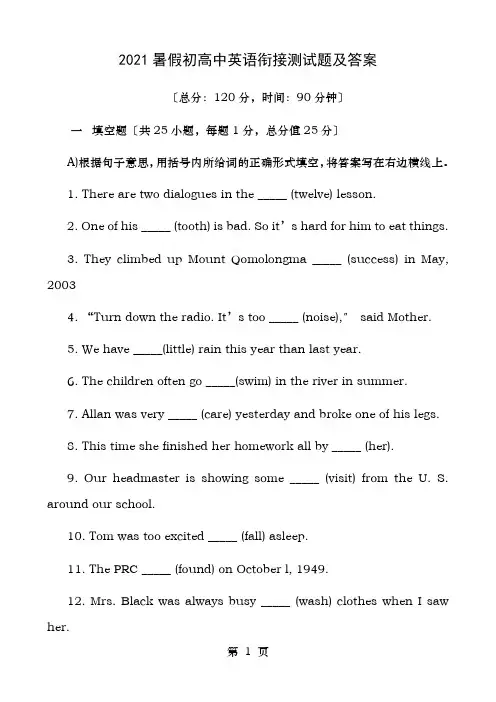
2021暑假初高中英语衔接测试题及答案〔总分:120分,时间:90分钟〕一填空题〔共25小题,每题1分,总分值25分〕A)根据句子意思,用括号内所给词的正确形式填空,将答案写在右边横线上。
1. There are two dialogues in the _____ (twelve) lesson.2. One of his _____ (tooth) is bad. So it’s hard for him to eat things.3. They climbed up Mount Qomolongma _____ (success) in May, 20034. “Turn down the radio. It’s too _____ (noise),〞said Mother.5. We have _____(little) rain this year than last year.6. The children often go _____(swim) in the river in summer.7. Allan was very _____ (care) yesterday and broke one of his legs.8. This time she finished her homework all by _____ (her).9. Our headmaster is showing some _____ (visit) from the U. S. around our school.10. Tom was too excited _____ (fall) asleep.11. The PRC _____ (found) on October l, 1949.12. Mrs. Black was always busy _____ (wash) clothes when I saw her.13. You cannot cross the street until the light _____ (turn) green.14. Do you know the girl _____ (call) Alice15. --Why don' t you go to the cinema with us--Because I _____ (see) the film.B)根据句子意思及汉语提示,写出所缺的单词,将答案写在右边横线上。
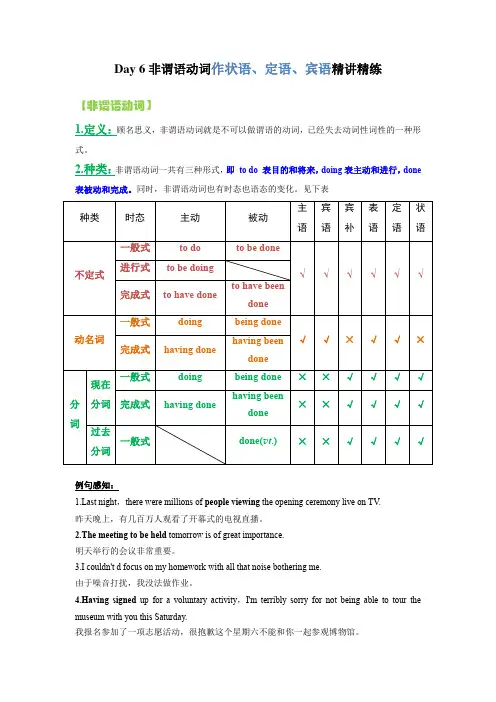
Day 6非谓语动词作状语、定语、宾语精讲精练【非谓语动词】1.定义:顾名思义,非谓语动词就是不可以做谓语的动词,已经失去动词性词性的一种形式。
2.种类:非谓语动词一共有三种形式,即to do 表目的和将来,doing表主动和进行,done 表被动和完成。
同时,非谓语动词也有时态也语态的变化。
见下表例句感知:st night,there were millions of people viewing the opening ceremony live on TV.昨天晚上,有几百万人观看了开幕式的电视直播。
2.The meeting to be held tomorrow is of great importance.明天举行的会议非常重要。
3.I couldn't d focus on my homework with all that noise bothering me.由于噪音打扰,我没法做作业。
4.Having signed up for a voluntary activity,I'm terribly sorry for not being able to tour the museum with you this Saturday.我报名参加了一项志愿活动,很抱歉这个星期六不能和你一起参观博物馆。
3.用法之非谓语动词作状语非谓语动词做状语是高中阶段必须熟练掌握且正确应用的语法点,是非谓语动词极为高频的用法。
非谓语动词作状语时,其逻辑主语通常要与句子的主语保持一致。
1.现在分词作状语现在分词作状语,常表原因、伴随、时间、结果等,与句子主语之间存在逻辑上的主谓关系。
Lying still in the grass,waiting,he heard the sound of the wild.他静静地躺在草丛里,等待着,天籁之音不绝于耳。
Aiming to improve our spokrn English, an English speech contest will be held tomorrow.旨在提高我们的英语口语,明天将会举行一个英语演讲比赛。
I. Multple Choice Part 11、The knife we used to cut the bread is very sharp.A.which B.with C.with it D.with which2、The brave man, the tiger was shot, is a good hunter.A.of whom B.by that C.by whom D.by which3、The clever boy made a hole in the wall, he could see what it was going on inside the house.A.on which B.at which C.through which D.in which4、The beautiful dress Miss Jones went to the ball was borrowed from a friend of hers.A.in which B.worn by C.through which D.on which5、During the days , he worked as a servant at the Browns’.A.that followed B.to follow C.following D.followed6、You may take anything useful .A.which you want B.you want them C.what you want D.you want7、My hometown is no longer the same it used to be.A.like B.that C.as D.which8、The old woman has two sons, one is a teacher.A.of who B.of whom C.of which D.of them9、You can take any seat is free.A.in which B.that C.where D.which10、Is there anything to you?A.that belong B.which belongs C.that belongs D.that is belonged11、We hope to get such a tool he is using.A.where B.that C.as D.which12、Finally came the day he had to begin his study for the next term.A.till B.that C.since D.which13、She hasn’t got enough money she buys the rings.A.for which B.with which C.that D.which14、I’ve read all the books were borrowed from the library.A.they B.which C./ D.that15、This is the best hotel in the city I know.A.it B.where C.that D.which16、Is oxygen the only gas helps fire burn?A.it B.which C./ D.that17、The Second World War millions of people were killed ended in 1945.A.on which B.where C.in that D.during which18、The train she was traveling was lateA.on that B.for which C.on which D.which19、Winter is the time of year the days are short and nights are long.A.on which B.that C.when D.where20、I’ll show you a store you may buy all you need.A.that, that B.which, that C.where, which D.in which, /21、I still remember the day she first wore that pink dress.A.on which B.on that C.in which D.which22、Do you know the reason she got so angry yesterday ?A.why B.which C.for that D.for why23、Is some German friends visited last week ?A.this school where B.this school one C.this the school D.this school24、Is there any one in your class family is in the city.A.whose B.which C.who’s D.who25、Can you lend me the book the other day ?A.which you talked B.that you talked C.about that you talked D.you talked about 26、This is one of the best films this year.A.which has been shown B.that have been shown C.that have shown D.have been shown 27、Do you know the man ?A.that I spoke B.I spoke to C.to who I spoke D.whom I spoke28、There are two thousand students in our school, are girls.A.two-thirds in which B.two-thirds in them C.two-thirds of them D.of whom two thirds 29、I have bought two ball-pens, writes well.A.neither of them B.none of them C.neither of which D.none of which30、He built a telescope he could study the skies.A.by it B.through which C.with that D.in which31、Do you know the reason he was late?A.for which B.for what C.which D.that32、has been said above, grammar is a set of dead rules.A.As B.That C.What D.Which33、John got beaten in the game, had been expected.A.who B.what C.that D.as34、They’re invented me to their party, is kind of them.A.this B.that C.which D.as35、Crusoe’s dog became ill and died, made him very lonely.A.this B.that C.which D.as36、There isn’t so much noise in the country in big cities.A.as B.where C.which D.that37、I often thought of my childhood, I lived on a farm.A.who B.when C.where D.which38、Next month, you’ll be in your hometown, is coming.A.where B.when C.that D.which39、The next thing must be done is to make a plan.A.which B.that C.when D./40、He talked happily about the men and books interested him greatly in the school.A.that B.when C.who D.which定语从句专项训练Part 21. We should do more oral practice next week, I think ,_____we did yesterday.A. whichB. thatC. asD. what2. The first thing _____you should do after school is to tell the head teacher the truth .A. thatB. whichC. whatD. for which3.—How do you find the camera ?----It is quite different from ____I lost last month.A . which B. that C. 不填 D. the one4.---Was _____Peter, _____played tennis well ,______helped the blind man cross the street?----Yes, you are right.A. it; who; thatB. which; that ; thatC. who; which ; thatD. it ; that; who5. Goodness! I have found ______gold watch ______I lost the other day.A. the same ; whichB. the same ; thatC. the same ; as whichD. as the same ; as6. This factory will not take on anyone ______eyesight is weak.A. of whichB. whomC. of thatD. whose7. I shall never forget the day ______Liu Xing won the gold medal, _____has a great effect on my life.A. when; thatB. that; whichC. which; thatD. when ;which8. In order to encourage the student to work hard , the school decides to five the scholarship to ____wins the first in the exams. A. whoever B. whomever C. who D. whom9._______is mentioned above, the number of the students in high schools has become larger in the past few years.A. ItB. AsC. WhatD. Which10. The operation turned out to be very successful ,________was ,ore than we could expect.A. itB. thatC. whichD. what11. In a word , the hours ______the children spend in their one-way relationship with television people undoubtedly affect their relationships with real-life people.A. in whichB. on whichC. whenD. that12. They traveled together as far as New York,_______ they parted.A. whereB. thatC. whenD. which13. Life in such a wild area has its problems ,______ getting water is not the least.A. in whichB. of whichC. with whichD. to which14. It was in the very house ______was build with wood _______the Japanese spent his childhood.A. which ;whereB. which; thatC. that whereD. that ;that15. This is the one of the happiest days _______spent in my life.A. which was everB. that have never beenC. that has ever beenD. we have never16. Love has nothing to do with what you are expecting to get--only with what you are expecting to give---_____iseverything. A. what B. this C. which D. one17. Here is the watch _____in the shop window.A. you saw itB. that you saw itC. that saw itD. you saw18. Mr Smith will move into his new house next Monday , _____it will be completely finished.A. whenB. by which timeC. in whichD. by that time19. On the table she found a piece of paper _____some puzzling secret codes.A. which was writtenB. that was writtenC. on which were writtenD. on that was written20. Whenever I met her, ______ was fairly often ,I liked her sweet and hopeful smile.A. itB. whichC. whatD. that21.---I was told your sister does well in arts. ----Sure. My sister is fond of painting and singing , besides ,_____is excellent.A. each of whichB. neither of whichC. neither of themD. each of them22. The student forgot to bring his dictionary,______ is often the case.A. thatB. whichC. asD. whether23. Culture refers to a group of community ____we share common experiences that shape the way we understand the world.A. with whichB. thatC. whichD. what24.The direction _____ a force is acting can be changed .A. thatB. whichC. from whichD. where25. The place _____ the bridge is suppose to be built should be _______the cross-river traffic is the heaviest.A. which; whereB. at which ; whichC. at which ; whereD. which ; in which26. Jim passed the driving test ,________surprised everybody in the office.A. whichB. thatC. this D .it27.Many people who had seen the film were afraid to go to the forest when they remembered the scenes ______people wereeaten by the tiger.A. in whichB. by whichC. whichD. from which28. _______came back first ______to win the first prize.A. The one who ; supposedB. No matter who ; was supposed C Those who ; supposed D. Whoever; was supposed29. Keep away from whatever things _____will do you harm..A. thatB. thoseC. asD. which30. Can you tell me the reason ________he gave for her absence from school?A. whyB. forC. whatD. thatⅡ、Fill in the blanks:1、This is the professor taught me chemistry in 1980 .2、The hospital was built five years ago has been modernized.3、This is the boy father died three years ago.4、The film we saw the day before yesterday is very interesting.5、Do you know the student was praised at the meeting?6、1949 is the year the People’s Republic of China was founded.7、They work in a factory makes radio parts.8、They work in a factory radio parts are made.9、This is the vision phone through we can see and talk to our friends.10、Here are players from Japan, some of are our old friends.11、She lives in a small village, is only three miles from here.12、She is going to spend the summer holidays in Shanghai, she has some friends.13、We’ll put off the meeting till next wee k, we won’t be so busy.14、The sun gives the earth light and heat, is very important to the living things.15、Those want to go to the computer room write your names here.16、He was often late, made his teacher very angry.17、Who is the person is standing at the gate?18、He talked about the teachers and schools he had visited.案Ⅰ、Part 11、D2、C3、C4、A5、A6、D7、C8、B9、D 10、C11、C 12、B 13、B 14、D 15、C16、D 17、D 18、C 19、C 20、D21、A 22、A 23、C 24、A 25、D26、B 27、B 28、D 29、C 30、B31、A 32、A 33、D 34、C 35、C36、A 37、B 38、B 39、B 40、APart 2 CADAB DDABC DABDC CDBCB ACAAC AADADⅡ、1、who / that 2、which / that 3、whose 4、which / that5、who / that6、when7、which / that8、where9、which 10、whom 11、which 12、where13、when 14、which 15、who 16、which17、that 18、that。
高一化学初高中知识衔接解析与练习主要内容主要通过对物质的组成、分类以及物质之间的关系的总结,对初中所学内容进行整合,又为高中化学的学习打下基础;使同学们能在直观的层面上较明显的认识物质分类及同类物质间的相似性及其应用;认识分类这种科学方法对化学研究的作用;了解物质的组成、结构和性质的关系;起到初中化学和高中化学衔接的作用;知识点精析化学是研究物质的组成、结构、性质及变化规律的一门自然科学;在初中我们已经了解了一些物质组成和结构的知识,对元素、分子、原子——等基本概念有了一定的认识;进入高中的学习我们不仅要能从以前学过的微观、宏观来认识物质,更应该从物质的结构入手以体会结构决定性质;当然除了了解物质的组成我们还会在今后进一步去学习那些肉眼看不到的微粒是靠什么作用结合在一起的,这些作用会导致物质的性质有什么不同,从而理解物质结构决定性质的道理;随着人类社会的进步,科学知识的丰富,原来那些只靠经验得到的化学成果已经无法满足人类的需求;一系列新的问题摆在化学家的面前要求得到圆满的回答;为什么煤能燃烧而其他的岩石却不能金属为什么会生锈为什么柔软的高岭土经过高温的焙烧就变成了晶莹坚固的花瓶要得到这些问题的谜底,人类就必须对世界上的一切物质进行研究;可是我们所研究的对象是一个非常庞大的集体,所以为了更好地认识物质,人们常根据物质的组成、状态、性能等对物质进行分类;“分类”是学习化学非常重要的一个学习方法;例如:根据组成对物质的分类:混合物、纯净物;单质、化合物;金属、非金属;氧化物、酸、碱、盐,我们可将它们以图表的形式展现出来;例如:各类物质的概念及代表物在这里要说明的是同一类物质在性质上相似,例如酸性氧化物,它还有一个俗名叫酸酐;我们中学所学的酸酐中大多数都能溶于水,不溶于水的很少像SiO2;于是同学们在学习的时候就应该记少的那半儿;而碱性氧化物中能溶于水的比较少见的有K、Na、Ba、Ca的氧化物;如何判断酸性氧化物和它对应的酸呢我们从已学过的知识入手,例如:C的氧化物我们学过两种即CO、CO2,那么谁是H2CO3的酸酐呢我们的回答应该是CO2,它们之间的关系呢进一步观察我们会发现CO2、H2CO3中的C元素都是+4价,因此今后我们可以用这种方法去判断酸性氧化物和它对应的酸;我们知道化学的研究对象是物质,随着学习的不断深入,你还要用发展的眼光不断地总结积累,你会发现碱性氧化物都是金属氧化物而酸性氧化物不都是非金属氧化物;当然物质分类的方式不仅一种,根据我们研究的对象及内容的不同,可把我们研究的物质按不同的方式分类;例如:酸我们可以按元数分电离H原子的个数;从是否含氧含氧酸、无氧酸;从电离的程度强酸和弱酸;做氧化剂的元素的不同氧化性酸和非氧化性酸等;同理,像碱、盐等其它物质也可以多种分类;通过把不同的物质进行分类,我们会发现同一类别的物质在性质上有相似的地方即我们通常说的通性,然后在今后的学习中我们再通过物质结构等知识的学习,进一步去研究物质间的规律,就会逐步掌握元素化合物学习的规律和方法,变被动学习为主动学习;物质分类的作用除了便于了解掌握同类物质的性质还在于引导我们去发现物质之间的转化关系,下面我们就对单质、氧化物、酸、碱和盐之间的相互关系进行以下讨论:O2H2O ()C——()——()——CaCO3()()HClBa——()——Ba(OH)2——()相信同学们利用初中所学知识不难完成上述转化关系,接下来同学们可以以单质、氧化物、酸、碱和盐分别为出发点去寻找它们之间的反应关系并将它们之间的关系绘制成一个表格,在这里给同学们举一个例子:从这两条系列、八个点,我们不难看出这些物质在纵向上的衍生关系以及横向及交叉的相互关系,八点图间蕴藏了多少化学反应,下面我们就重点解读一下“八点图”中的反应;1. 金属单质+非金属单质→无氧酸盐2. 碱性氧化物+酸性氧化物→含氧酸盐3. 碱+酸→盐+水4. 酸性氧化物+碱→盐+水5. 碱性氧化物+酸→盐+水6. 酸+盐→新酸+新盐7. 碱+盐→新碱+新盐8. 盐+盐→新盐+新盐9. 金属单质+盐→金属单质+盐10. 金属单质+酸→盐+H2我们应该怎样运用这些关系,在用的过程中要注意些什么呢一. 找规律:我们都很熟悉碱+酸→盐+水,通过对3、4、5的观察你会发现酸性氧化物广义上来讲就是酸,碱性氧化物在广义上就是碱,这样在今后的学习中我们就可以用这个规律去书写化学方程式;例如:CO2+CaOH2=CaCO3↓+H2O SO2+CaOH2=CaSO3↓+H2O二. 反应条件限制:1. 酸+金属→盐+H2金属为活泼金属;酸一般用稀硫酸、稀盐酸;不用两者,稀HNO3制备氢气时,不用K、Ca、Na特别活泼的金属;2. 碱+盐碱+盐反应时要求两者都必须可溶,生成物之一为不溶即可;3. 碱+指示剂碱必须可溶;三. 酸和盐反应的规律:1. 强酸制备弱酸 2HCl+CaCO3=CaCl2+CO2↑+H2O2HCl+Na2SO3=2NaCl+SO2↑+H2O2. 高沸点、难挥发性酸制备低沸点、易挥发性酸2NaCl+H2SO4浓=Na2SO4+2HCl↑ NaNO3+H2SO4浓=NaHSO4+HNO3↑当然我们不是想把所有的知识局限在“八点图”上,而是以它为例说明如何寻找各类物质之间的关系,同学们也可以从不同的角度进行总结归纳;解题方法指导例1. 下列说法正确的是:A非金属氧化物都是酸性氧化物B凡是酸性氧化物都可以直接与水反应生成相对应的酸C与水反应生成酸的氧化物,不一定是该酸的酸酐D金属氧化物都是碱性氧化物本题考察同学对氧化物的分类,酸酐及酸的认识,由于像CO、NO这些不成盐氧化物所以A不对;SiO2难溶于水,Al2O3为两性氧化物故C正确;2. 下列关于氧化物的叙述正确的是:A酸性氧化物均可与碱反应B酸性氧化物在常温常压下均为气态C金属氧化物都是碱性氧化物 D不能跟酸反应的氧化物一定能跟碱反应本题要求利用初中对酸性氧化物性质的知识的积累,不难得出酸性氧化物在广义上可认为就是酸,不难得出A正确;3. 下列物质中:①Cl2O7,HClO ②SO2,H2SO4③NO2,HNO3④SiO2,H2SiO3⑤Mn2O7,HMnO4酸与酸酐相对应的是A②③ B③④ C④⑤ D①③④抓住酸酐与其对应的酸中该元素的化合价一致这一特点即可选出C正确;典型例题分析1. 只含有一种元素的是A. 可能是纯净物也可能是混合物B. 可能是单质也可能是化合物C. 一定是纯净物D. 一定是一种单质解析:在今后的学习中我们还要学习同素异形体的概念,即同种元素组成的不同的单质叫做同素异形体,那么像P元素可以形成白磷或红磷等单质,而白磷或红磷是两种不同的物质;所以A选项正确;2. 下列有关氧化物的叙述正确的是A. 酸性氧化物均可跟碱起反应B. 金属氧化物都是碱性氧化物C. 非金属氧化物都是酸性氧化物D. 不能跟酸反应的氧化物一定能跟碱反应解析:在高中的学习中要不断地总结和积累,逐渐加深对概念的理解;例如:Al2O3是两性氧化物,NO、CO是不成盐氧化物既不与酸也不与碱反应成盐;因此,只有A正确;3. 00年全国下列广告用语在科学性上没有错误的是A. 这种饮料中不含有任何化学物质B. 这种蒸馏水绝对纯净,其中不含有任何离子C. 这种口服液含丰富的氮、磷、锌微量元素D. 没有水就没有生命解析:这是生活中经常遇到的话,考察同学们对基本概念的综合应用能力;答案为D强化练习一、标出下列指定元素的化合价N.2、N.H3、N.H4Cl、N.O、N.O2、N.2O4、HN.O3;H2S.、S.O2、S.O3、H2S.O4、BaS.O4;C.l2、NaC.l、HC.l、HC.lO、HC.lO4、HC.lO3、KC.lO3;C.H4、C.O、C.O2、H2C.O3、NaHC.O3、CaC.O3;在下列化合物中根原子团下方划一短线,并标出根的化合价① KOH ② Na2CO3③ BaSO4④ NH4Cl ⑤ AgNO3⑥ KMnO4⑦ NH4NO3⑧ Cu2OH2CO3⑨ KClO3⑩ K2MnO4二、写出下列物质的化学式碳酸___ ___、碳酸钠__ ____、碱式碳酸铜______________、碳酸氢钠_________、碳酸钙__________、碳酸氢钙_____________;氯化氢_________、氯气________、氯化钾___________、二氯化锰___________、氯酸___________、氯酸钾___________、二氧化氯___________、氧化二氯___________;硝酸___________、硝酸钾___________、硝酸钡___________、硝酸铵___________、硝酸铜___________、硝酸汞___________、硝酸银___________;硫酸___________、硫酸铵___________、硫酸氢铵___________、硫酸钡___________、硫酸铝___________、硫酸铁___________、硫酸亚铁___________;磷酸___________、磷酸钠___________、磷酸氢钠___________、磷酸氢二钠___________、磷酸氢铵___________、磷酸钙___________、磷酸二铵___________;氮气、硫磺、白磷、金刚石、氦气、二氧化硅、氖气、二氧化氮、氩气、氧化铁、氧化铝;氢氧根离子、硫酸根离子、碳酸根离子、硝酸根离子、铵根离子 ;三、写出下列反应的化学方程式1.三氧化硫和水反应_____________________________2.氧化钙和水反应_______________________________3.氧化钠和水反应_______________________________4.二氧化碳和澄清的石灰水反应_______________________________5.碳酸钙高温分解_______________________________6.碳和二氧化碳高温反应_______________________________7.乙醇在空气中燃烧_______________________________8.铁和稀硫酸_______________________________9.氧化铜和碳加热_______________________________10.氧化铁和CO加热_______________________________11.四氧化三铁和CO加热_______________________________12.碱式碳酸铜加热_______________________________13.氢氧化铁中加入稀硫酸_______________________________14.氧化铁中加入到稀硝酸中_______________________________15.铁和硝酸汞溶液反应_______________________________16.少量的锌加入到FeSO4和稀硫酸的混合液中_______________________________17.碳酸氢钙溶液中滴加盐酸_______________________________18.碳酸镁中加入硫酸_______________________________19.写出有O2生成的三个反应______________________________________________________________、_______________________________20.写出有水和气体生成的三个反应______________________________________________________________、_______________________________四.写出下列物质在水中的电离方程式1.碳酸钠 2.硫酸3.硝酸 4.硝酸铜5.碳酸氢钙 6.硝酸铵7.硫酸铝 8.高锰酸钾9.氯酸钾 10.氢氧化钙11.磷酸钠 12.硝酸钡13.氯化铁 14.氯化铵五、实验题1.下列各组物质中,都含有少量的杂质,分别用什么试剂可以将括号内的杂质除去只要求写所加物质的名称或方法及化学方程式lCOCO2;2KClKClO3;3KNO3KCl ;4NaClNa2CO3;5FeSO4CuSO4;b 6NaOHCaOH 2 ;7CuNO 32CuSO 4 ;2.只用一种试剂鉴别下列物质,在横线上填所加试剂的化学式或名称lBaCl 2、NaCl 、K 2CO 32NaNO 3、MgCl 2、NH 42SO 43CaCl 2、NaNO 3、H 2SO 44NaCl 、H 2SO 4、CaOH 23.从玻璃棒、漏斗、100毫升量筒,胶头滴管,试管夹、10毫升量筒,铁架台,药匙等仪器中,选取合适的仪器填入下列横线上:2%1取用粉末状药品要用 ;2量取5毫升液体用 ;3给试管里的物质加热,必须使用 ;4.如下图所示,该装置有洗气、检验及储气等多种用途;1若用此装置来除去氢气中混有的少量水蒸气时,在广口瓶内应该盛放的试剂是2若要验证氢气中是否混有氯化氢气体,广口瓶内应该盛放的试剂是3若用来收集气体,当气体从b 端通入时,能收集到的气体可以是 ;5.只有氯化钡溶液和简单的仪器装置,鉴别稀硫酸和碳酸钠溶液任意编号为甲、乙溶液;操作如下: 1 分别取少量甲、乙溶液于两支试管中,各滴加氯化钡溶液,两支试管中都产生白色沉淀;下面还要进行怎样的操作,才能把它们鉴别出来;将鉴别的步骤、现象及最终结论,填写在相应的横线上;2 _______________________________________________________3_______________________________________________________附: 强化练习答案:一、1、0、—3、—3、+2、+4、+4、+5;—2、+4、+6、+6、+6;0、—1、—1、+1、+7、+5;—4、+2、+4、+4、+4、+4;2、① KOH ② Na 2CO 3 ③ BaSO 4 ④ NH 4Cl ⑤ AgNO 3⑥ KMnO 4 ⑦ NH 4NO 3 ⑧ Cu 2OH 2CO 3 ⑨ KClO 3 ⑩ K 2MnO 4二、H 2CO 3、Na 2CO 3、Cu 2OH 2CO 3、NaHCO 3、CaCO 3、CaHCO 32;HCl 、Cl 2、KCl 、MnCl 2、HClO 3、KClO 3、ClO 2、Cl 2O ;HNO 3、KNO 3、BaNO 32、NH 4NO 3、CuNO 32、HgNO 3、AgNO 3;H 2SO 4、NH 42SO 4、NH 4HSO 4、BaSO 4、Al 2SO 43、Fe 2SO 43、FeSO 4;H 3PO 4、Na 3PO 4、Na 2HPO 4、Na 2HPO 4、NaH 2PO 4、NH 42HPO 4、Ca 3PO 42、NH 42HPO 4、N 2、S 、P 、C 、He 、SiO 2、Ne 、NO 2、Ar 、Fe 2O 3、Al 2O 3;OH -、SO 42-、CO 32-、NO 3-、NH 4+;三、1、SO 3+H 2O=H 2SO 4 2、—1 —1 —1 +1 —1 —2 —1 —1 —2 —2 +1 —2CaO+H2O=CaOH2 3、Na2O+H2O=2NaOH 4、CaCO3+CO2少量=CaCO3↓+H2O、CaCO3+CO2过量=CaHCO3;5、CaCO3高温CaO+CO2↑ 6、C+CO2高温2CO 7、C2H6O2+3O2点燃2CO2+3H2O;8、Fe+H2SO4=FeSO4+H2↑;9、2CuO+C △2Cu+CO2;10、Fe2O3+3CO△2Fe+3CO2;11、Fe3O4+4CO△3Fe+4CO2;12、Cu2OH2CO3△2↑+H2O;13、2FeOH3+3H2SO4=Fe2SO43+3H2O;14、Fe2O3+6HNO3=2FeNO33+3H2O;15、Fe+HgNO2=Hg+FeNO32;16、Zn+CuSO4=ZnSO4+Cu;17、CaHCO32+2HCl=CaCl2+CO2+H2O;18、MgCO3+H2SO4=MgSO4+CO2+H2O 19、2KClO3△2KCl+3O2、2KMnO4△K2MnO4+MnO2+O2↑、2H2O电解2H2↑+O2↑;20、Na2CO3+2HCl=2NaCl+CO2↑+H2O、NaHCO3+HCl=NaCl+CO2↑+H2O、NH4HCO3△NH3↑+H2O+CO2↑四、1、Na2CO3=2Na++CO32—;2、H2SO4=2H++SO42—;3、HNO3=H++NO3—;4、CuNO32=Cu2++2NO3-;5、CaHCO32=Ca2++2HCO3—;6、NH4NO3=NH4++NO3—;7、Al2SO43=2Al3++3SO42—;8、KMnO4=K++MnO4—;9、KClO3=K++ClO3—;10CaOH2=Ca2++2OH—;11、Na3PO4=3Na++PO43—;12、BaNO32=Ba2++2NO3—;13、FeCl3=Fe3+3Cl—; 14、NH4Cl=MH4++Cl—;五、1、1NaOH溶液;2NaOH+CO2=Na2CO3+H2O;2加热,2KClO3 △2↑;3AgNO3溶液,AgNO3+KCl=AgCl↓+KNO3;4HCl,Na2CO3+2HCl=2NaCl+CO2↑+H2O;5Fe,Fe+CuSO4=FeSO4+Cu;6Na2CO3,Na2CO3+CaOH2=CaCO3↓+2NaOH;7BaNO32,BaNO32+CuSO4=BaSO4↓+CuNO32;2、1稀H2SO42NaOH溶液3Na2CO3溶液4Na2CO3溶液;3、1药匙210mL量筒 3试管夹4、1浓H2SO42紫色石蕊试液3H2、NH3;5、2取与甲反应后浊液过滤,将滤液滴入乙中;3若乙中白色沉淀溶解,则甲为H2SO4,乙为Na2CO3;若乙中沉淀不溶解,则甲为Na2CO3,乙为H2SO4;。
初高中衔接阅读中反讽手法考点示例与强化练习考点:1.罗伯特·M·罗斯《爱时而脆弱》——对本文艺术特色的分析鉴赏2.契诃夫《第六病室(节选)》——“在荒诞外表下包裹着讽刺的内核”3.(北宋)柳永《破阵乐·露花倒影》——对本词相关内容的理解与赏析4.欧·亨利《喂鸽者》——“反讽性”【考点研究】1.对本文艺术特色的分析鉴赏2.“在荒诞外表下包裹着讽刺的内核”3.对本词相关内容的理解与赏析4.“反讽性”【考点示例】一、罗伯特·M·罗斯《爱时而脆弱》——对本文艺术特色的分析鉴赏【考点解读】1.对本文相关内容的理解2.对本文艺术特色的分析鉴赏3.鉴赏小说句子表达效果4.概括分析小说情节以及作用文本爱时而脆弱【美国】罗伯特·M·罗斯再怎么伤心的人,也不得不吃东西。
咒骂了女人、食物及其他人们追之不倦的事物之后十六个小时,丹顿来到街角的一家杂货店,吞了一份凤梨圣代,两份花生酱三明治,一块掺了麦芽糖的双层巧克力,外加一袋饼干。
店里有个女孩。
女孩坐下时,他瞥了一眼,站起来时他瞥了一眼;离开时,他瞥了两眼。
付过账离开了杂货店,他朝北走去。
这可是与他原来打算走的方向一百八十度的不同。
他希望那女孩的步伐别迈得那么大,要从一街之遥一下子赶上去,他办不到。
“嗨!你也走这条路?”他说。
她只是把头转过来,长长的睫毛对着他眨了眨,然后继续坚定地走下去。
“假如你迷了路,”他又试了一次,“我可以告诉你你在那里,这个地方我住了好多年了。
”女孩仍然不为所动。
他开始觉得困窘,不过还不到足以教他打退堂鼓的地步。
“左边是菲尔德宅子,”他说。
“自从菲尔德先生买下它以后,它就一直叫做菲尔德宅子。
他们的女儿是一丝不苟型的,但儿子们却油里油气。
如果我是你,我不会在这种地方停留的。
”女孩是没有停留。
她有着清晰的侧轮廓,尖端微翘的俏皮的鼻子。
虽然吃了闭门羹,丹顿的耳朵却痒了起来。
2021年暑期初高中衔接英语语法专项练习:I名词和冠词(含答案)初高中衔接英语语法专项练习I.名词和冠词1.beyond________stars,theastronautsawnothingbut________space.a、这个;xb。
十、xc。
十、泰德。
这个2。
亚历山大·格雷厄姆于1876年发明了电话。
a.xb.ac.thed.one3.________terribleweatherwe’rehavingthesedays!a、霍瓦布。
哇。
你好。
什么杰克在哪里?―ithinkhe’sstillin________bed,buthemightjustbein________bathroom.a.x;xb. the;thec.the;xd.x;the5.wehaveworkedouttheplanandnowwemustputitinto________.a、事实B。
真的。
练习。
行为6.manypeoplearestillin________habitofwritingsillythingsin________publicplaces.a、这个;泰伯。
十、xc。
这个除息的。
十、7号。
他把它摔碎了。
a.cupofcoffeeb.coffee’scupc.cupforcoffeed.coffeecup8.―howdidthebosspayyou?―通常情况下,我们会这样做。
a、再见。
再见。
拜恩霍尔德。
9小时前。
我很高兴见到他,因为他已经走了。
a.manykindnessb.lotsofkindnessc.manykindnessesd.muchkindn ess10.―couldyouleave meyourdictionary?―当然,但实际上是这样。
a、穆库塞布的。
非常有用。
非常安静。
表格11在斯特里克纳地区非常需要。
a.alotofclothesb.manyaclothc.muchclothingd.plentyofclothes12.去年,老妇人在她家里雇了两个。
初高中衔接型中考数学试题(5)及参考答案1、(河北03/20)如图:是用火柴棍摆出的一系列三角形图案,按这种方式摆下去,当每边上摆20(即n =20)根时,需要的火柴棍总数为 根。
••••••••••••••••••••••••••••••1=n 2=n 3=n 2、观察下列图形,并阅读图形下面的相关文字:两条直线相交, 三条直线相交, 四条直线相交,……最多有1个交点; 最多有3个交点; 最多有6个交点;……像这样,十条直线相交,最多交点的个数是 ( )A.40个B.45个C.50个D.55个3.一种浓度是15%的溶液30千克,现要用浓度更高的同种溶液50千克和它混合,使混合后的浓度大于20%,而小于35%,则所用溶液浓度x 的取值范围是( )(A )15%<x<23% (B )15%<x<35% (C )23%<x<47% (D )23%<x<50%4、(贵阳03/25)如图,圆柱的轴截面ABCD 是边长为4的正方形,动点P 从A 点出发,沿着圆柱的侧面移动到BC 的中点S 的最短距离是( )(A )212π+ (B )2412π+ (C )214π+ (D )242π+ 5、(黄冈市2003年)同学们都做过《代数》课本第三册87页第4题:某礼堂共有25排座位,第一排有20个座位,后面每一排都比前一排多1个座位,写出每排的座位数m 与这排的排数n 的函数关系式并写出自变量n 的取值范围.答案是:每排的座位数m 与这排的排数n 的函数关系式是m=n+19;自变量n 的取值范围是1≤n ≤25,且n 是整数.上题中,在其它条件不变的情况下,请探究下列问题:(1)当后面每一排都比前一排多2个座位,则每排的座位数m 与这排的排数n 的函数关系式是 m=2n+18 (1≤n ≤25, 且n 是整数).(2)当后面每一排都比前一排多3个座位、4个座位时,则每排的座位数m 与这排的排数n 的函数关系式分别是 m=3n+17, m=4n+16, , (1≤n ≤25, 且n 是整数).(3)某礼堂共有p排座位,第一排有a 个座位,后面每一排都比前一排多b 个座位,试写出每排的座位数m 与这排的排数n 的函数关系式,并指出自变量n 的取值范围.75S PD C BA初高中衔接型中考数学试题(5)及参考答案1、答:630根。
初高中数学衔接教材第二课时课前练习:解下列不等式:(1)21x -< (2)213x +> (3)13x x -+->4.1.1乘法公式我们在初中已经学习过了下列一些乘法公式:(1)平方差公式 22()()a b a b a b +-=-;(2)完全平方公式 222()2a b a ab b ±=±+.我们还可以通过证明得到下列一些乘法公式:(1)立方和公式 2233()()a b a ab b a b +-+=+;(2)立方差公式 2233()()a b a ab b a b -++=-;(3)三数和平方公式 2222()2()a b c a b c ab bc ac ++=+++++;(4)两数和立方公式 33223()33a b a a b ab b +=+++;(5)两数差立方公式 33223()33a b a a b ab b -=-+-例题解析:例1 计算:(1)22(1)(1)(1)(1)x x x x x x +--+++.(2)42(2)(2)(416)a a a a +-++例2 已知4a b c ++=,4ab bc ac ++=,求222a b c ++的值.例3.已知3321,013x x x x +=+-求的值. 针对训练:1.填空,使之符号立方和或立方差公式:(1)(x-3)( )=x 3-27; (2)(2x+3)( )=8x 3+27;(3)(x 2+2)( )=x 6+8; (4)(3a-2)( )=27a 3-82.填空,使之符号立言和或立方差公式:(1)( )(a 2+2ab+4b 2)=__________; (2)( )(9a 2-6ab+4b 2)=__________;(3) ( )(41 -xy+4y 2)=__________; (4)( )(m 4+4m 2+16)=__________ 3.计算:(1)(y+3)(y 2-3y+9); (2)(c+5)(25-5c+c 2);(3)(2x-5)(4x 2+25+10x) (4)(2a+b)(4a 2-4ab+b 2)(5) (6) 3.已知x 2+y 2=6,xy=2,求x 6+y 6的值.1.2 分解因式1.分组分解法例1 分解因式:(1)32933x x x +++; (2)12422+--a b a(3)ay bx by ax +-- (4)x x x x -+-235 (5)14424---a a a2.立方差公式例2.分解因式:(1)66b a - (2)3232)(b m b a m -+ 3.十字相乘法例3.分解因式:(1)226y xy x -- (2)12)(8)(222++-+x x x x(3)25122--x x (4)2675x x -+ 针对训练:(1)232)2(a x a --(2)8a 3-b 3; (3)6466y x - (4)4)4)(2(2-++-x x x(5))(22a a x x --+ (6)y x xy -+-1 \\(7)2265a ax x +- (8)22352x xy y +- (9)m m x m x +++-22)12(。
1 初中化学强化练习题 一、标出下列指定元素的化合价
N.2、N.H3、N.H4Cl、N.O、N.O2、N.2O4、HN.O3; H2S.、S.O2、S.O3、H2S.O4、BaS.O4;
C.l2、NaC.l、HC.l、HC.lO、HC.lO4、HC.lO3、KC.lO3; C.H4、C.O、C.O2、H2C.O3、NaHC.O3、CaC.O3; 在下列化合物中根(原子团)下方划一短线,并标出根的化合价
① KOH ② Na2CO3 ③ BaSO4 ④ NH4Cl ⑤ AgNO3 ⑥ KMnO4 ⑦ NH4NO3 ⑧ Cu2(OH)2CO3 ⑨ KClO3 ⑩ K2MnO4 二、写出下列物质的化学式 碳酸______、碳酸钠______、碱式碳酸铜______________、碳酸氢钠_________、碳酸钙__________、碳酸氢钙_____________;氯化氢_________、氯气________、氯化钾___________、 二氯化锰___________、氯酸钾___________、二氧化氯___________、氧化二氯___________; 硝酸_________、硝酸钡__________、硝酸铵___________、硝酸铜___________、硝酸银___________;硫酸___________、硫酸铵___________、硫酸氢铵___________、硫酸钡___________、 硫酸铝___________、硫酸铁___________、硫酸亚铁___________; 磷酸___________、磷酸钠___________、磷酸氢钠___________、磷酸氢二钠___________、 磷酸氢铵___________、磷酸钙___________、磷酸二铵___________; 氮气 、硫磺 、白磷 、金刚石 、氦气 、二氧化硅 、氖气 、二氧化氮 、氩气 、氧化铁 、氧化铝 ;氢氧根离子 、硫酸根离子 、碳酸根离子 、硝酸根离子 、铵根离子 。 三、写出下列反应的化学方程式 1.三氧化硫和水反应_____________________________ 2.氧化钙和水反应_______________________________ 3.氧化钠和水反应_______________________________ 4.二氧化碳和澄清的石灰水反应_______________________________ 5.碳酸钙高温分解_______________________________ 6.碳和二氧化碳高温反应_______________________________ 7.甲烷在空气中燃烧_______________________________ 8.铁和稀硫酸_______________________________ 9.氧化铜和碳加热_______________________________ 10.氧化铁和CO加热_______________________________ 11.四氧化三铁和CO加热_______________________________ 12.碱式碳酸铜加热_______________________________ 13.氢氧化铁中加入稀硫酸_______________________________ 14.氧化铁中加入到稀硝酸中_______________________________ 15.铁和硝酸汞溶液反应_______________________________ 16.少量的锌加入到FeSO4和稀硫酸的混合液中_______________________________ 17.碳酸氢钙溶液中滴加盐酸_______________________________ 18.碳酸镁中加入硫酸_______________________________ 2
a b
19.写出有O2生成的三个反应_______________________________ _______________________________、_______________________________ 20.写出有水和气体生成的三个反应_______________________________ _______________________________、_______________________________ 四.写出下列物质在水中的电离方程式 1.碳酸钠 2.硫酸 3.硝酸 4.硝酸铜 5.碳酸氢钙 6.硝酸铵 7.硫酸铝 8.高锰酸钾 9.氯酸钾 10.氢氧化钙 11.磷酸钠 12.硝酸钡 13.氯化铁 14.氯化铵 五、实验题 1.下列各组物质中,都含有少量的杂质,分别用什么试剂可以将括号内的杂质除去(只要求写所加物质的名称或方法及化学方程式) (l)CO2(CO) ; (2)KCl(KClO3) ; (3)KNO3(KCl) ; (4)NaCl(Na2CO3) ; (5)FeSO4(CuSO4) ; (6)NaOH(Ca(OH)2) ; (7)Cu(NO3)2(CuSO4) ; 2.只用一种试剂鉴别下列物质,在横线上填所加试剂的化学式或名称 (l)BaCl2、NaCl、K2CO3 (2)NaNO3、MgCl2、(NH4)2SO4 (3)CaCl2、NaNO3、H2SO4 (4)NaCl、H2SO4、Ca(OH)2 3.从玻璃棒、漏斗、100毫升量筒,胶头滴管,试管夹、10毫升量筒,铁架台,药匙等仪器中,选取合适的仪器填入下列横线上: (1)取用粉末状药品要用 ; (2)量取5毫升液体用 ; (3)给试管里的物质加热,必须使用 ; 4.如下图所示,该装置有洗气、检验及储气等多种用途。
(1)若用此装置来除去氢气中混有的少量水蒸气时,在锥形瓶内应该盛放的试剂是 (2)若要验证氢气中是否混有氯化氢气体,锥形瓶内应该盛放的试剂是 (3)若用来收集气体,当气体从b端通入时,能收集到的气体可以是 。 5.有一不纯的一氧化碳气体,其中混有少量水蒸气和二氧化碳。现提供右图所示的甲、乙、丙三种装置(每种都有若干个),若用来①证明混有这两种气体②除去这两种气体 ③确认CO2已除尽。 (1) 甲装置的作用是________________________________________ a b 甲 c d 乙 e f
丙 3
丙装置的作用是________________________________________ (2) 为达到上述①—③的目的,用各装置接口的代号,表示出正确的连接顺序。 _____________________________________________ 6.只有氯化钡溶液和简单的仪器装置,鉴别稀硫酸和碳酸钠溶液(任意编号为甲、乙溶液)。操作如下: (1) 分别取少量甲、乙溶液于两支试管中,各滴加氯化钡溶液,两支试管中都产生白色沉淀。 下面还要进行怎样的操作,才能把它们鉴别出来。将鉴别的步骤、现象及最终结论,填写在相应的横线上。 (2) _______________________________________________________ (3)_______________________________________________________
答案: 4
一、 1、0、—3、—3、+2、+4、+4、+5;—2、+4、+6、+6、+6;0、—1、—1、+1、+7、+5;—4、+2、+4、+4、+4、+4; 2、① KOH ② Na2CO3 ③ BaSO4 ④ NH4Cl ⑤ AgNO3 ⑥ KMnO4 ⑦ NH4NO3 ⑧ Cu2(OH)2CO3 ⑨ KClO3 ⑩ K2MnO4 二、 H2CO3、Na2CO3、Cu2(OH)2CO3、NaHCO3、CaCO3、Ca(HCO3)2; HCl、Cl2、KCl、MnCl2、HClO3、KClO3、ClO2、Cl2O; HNO3、KNO3、Ba(NO3)2、NH4NO3、Cu(NO3)2、Hg(NO3)、AgNO3; H2SO4、(NH4)2SO4、NH4HSO4、BaSO4、Al2(SO4)3、Fe2(SO4)3、FeSO4; H3PO4、Na3PO4、Na2HPO4、Na2HPO4、NaH2PO4、(NH4)2HPO4、Ca3(PO4)2、(NH4)2HPO4、N2、S、P、C、He、SiO2、Ne、NO2、Ar、Fe2O3、Al2O3; OH-、SO42-、CO32-、NO3-、NH4+; 三、 1、SO3+H2O=H2SO4
2、CaO+H2O=Ca(OH)2
3、Na2O+H2O=2NaOH
4、CaCO3+CO2(少量)=CaCO3↓+H2O、CaCO3+CO2(过量)=CaHCO3;
5、CaCO3 高温 CaO+CO2↑
6、C+CO2 高温 2CO 7、CH4+2O2 点燃 CO2+H2O; 8、Fe+H2SO4=FeSO4+H2↑;
9、2CuO+C △ 2Cu+CO2; 10、Fe2O3+3CO △ 2Fe+3CO2; 11、Fe3O4+4CO △ 3Fe+4CO2; 12、Cu2(OH)2CO3 △ 2CuO+CO2↑+H2O; 13、2Fe(OH)3+3H2SO4=Fe2(SO4)3+3H2O; 14、Fe2O3+6HNO3=2Fe(NO3)3+3H2O; 15、Fe+Hg(NO)2=Hg+Fe(NO3)2; 16、Zn+CuSO4=ZnSO4+Cu; 17、Ca(HCO3)2+2HCl=CaCl2+CO2+H2O; 18、MgCO3+H2SO4=MgSO4+CO2+H2O
19、2KClO3 △ 2KCl+3O2、2KMnO4 △ K2MnO4+MnO2+O2↑、2H2O 电解 2H2↑+O2↑; 20、Na2CO3+2HCl=2NaCl+CO2↑+H2O、NaHCO3+HCl=NaCl+CO2↑+H2O、
NH4HCO3 △ NH3↑+H2O+CO2↑ 四、1、Na2CO3=2Na++CO32—; 2、H2SO4=2H++SO42—;
—1 —1 —1 +1 —1 —2 —1 —1 —2 —2 +1
—2